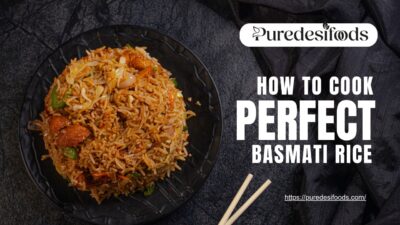Your Guide to Cooking Basmati Rice the Traditional Way
Cooking basmati rice may seem simple, but achieving fluffy, fragrant, and non-sticky grains requires the right technique. In Pakistani and South Asian households, perfectly cooked basmati rice is the heart of many traditional dishes — from biryani to pulao and daal chawal. In this guide, we’ll show you how to cook authentic basmati rice the traditional way, using time-tested methods passed down through generations.
Whether you’re preparing it for everyday meals or festive gatherings, this step-by-step tutorial will help you master the art of cooking perfect basmati rice at home.
Why Basmati Rice?
Basmati rice (باسمتی چاول) is a long-grain, aromatic rice variety native to the Indian subcontinent, widely used in Pakistani kitchens. Its distinctive fragrance, light texture, and fluffy nature make it ideal for dishes like:
- Chicken or beef biryani
- Vegetable pulao
- Matar chawal (peas rice)
- Zeera rice (cumin rice)
- Daal chawal
Compared to other rice types, basmati rice is lower in starch, which helps prevent stickiness and promotes separate grains after cooking.
Ingredients
To cook traditional basmati rice, you’ll need:
- 1 cup basmati rice (preferably aged)
- 4–5 cups of water
- ½ tsp salt (or to taste)
- 1 tbsp oil or ghee (optional, for aroma and separation)
- Whole spices (optional – 1 bay leaf, 2 cloves, 2 green cardamoms)
Step-by-Step Traditional Method to Cook Basmati Rice
Step 1: Rinse the Rice
Place the rice in a bowl and rinse under cold water 2–3 times until the water runs clear. This removes excess surface starch and prevents the rice from clumping.
SEO Tip: Rinsing is crucial for non-sticky basmati rice and better texture.
Step 2: Soak the Rice
Soak the rinsed rice in fresh water for 20–30 minutes. Soaking helps the grains absorb moisture and reduces cooking time, ensuring long, separate grains after cooking.
Pro Tip: Soaking aged basmati gives the best results in biryani and pulao recipes.
Step 3: Boil Water Separately
Bring 4–5 cups of water to a rolling boil in a large pot. Add salt and whole spices for extra aroma and flavor.
You can also add a few drops of lemon juice to keep the grains from breaking.
Step 4: Add the Soaked Rice
Drain the soaked rice and gently add it to the boiling water. Stir once to prevent sticking to the bottom.
Do not cover the pot. Let it boil on high heat.
Step 5: Cook Until 90% Done
Boil the rice uncovered until it’s about 90% cooked. This usually takes 6–8 minutes, depending on the brand and age of the rice.
Check by pressing a grain between your fingers — it should be soft on the outside with a slight bite in the center.
Step 6: Drain and Steam (Dum)
Once 90% cooked, strain the rice using a colander. Spread it evenly in a pan. Cover tightly with a lid and steam on very low heat for 10 minutes.
This “dum” process finishes the cooking, infuses aroma, and fluffs the rice perfectly.
Traditional Basmati Rice Cooking Tips
- Always use aged basmati rice for better texture and length.
- For added richness, use desi ghee instead of oil.
- Avoid stirring too much during cooking — it can break the grains.
- Use a heavy-bottom pan to prevent burning during steaming.
Health Benefits of Basmati Rice
- Low Glycemic Index (GI) – Ideal for diabetic-friendly meals.
- Gluten-Free – Safe for those with gluten intolerance.
- Rich in fiber – Supports digestion and gut health.
- Aromatic compounds – Natural fragrance without additives.
Frequently Asked Questions (FAQs)
1. Should I wash basmati rice before cooking?
Yes, washing helps remove excess starch and results in fluffier, non-sticky rice.
2. Can I cook basmati rice without soaking?
You can, but soaking improves the grain texture and reduces cooking time.
3. What’s the water-to-rice ratio for traditional basmati?
If you’re boiling and draining, use 4–5 cups of water for every 1 cup of rice.
4. Can I use a rice cooker for traditional basmati rice?
You can, but stovetop methods offer better control over texture, especially for Pakistani recipes like biryani or pulao.
Why Choose Pure Desi Basmati Rice?
At PureDesiFoods.com, we offer premium, aged basmati rice sourced directly from certified farms. Our rice is free from artificial fragrance and additives — naturally aromatic, fluffy, and long-grain. It’s the perfect rice for biryani lovers and everyday desi meals.
Experience the tradition of authentic Pakistani rice with every bite.
Final Thoughts
Cooking perfect basmati rice the traditional way doesn’t require fancy tools — just the right method, a bit of patience, and quality ingredients. When done right, it can elevate your entire meal, making simple dishes extraordinary.
Bring home the magic of tradition with Pure Desi Basmati Rice — fluffy, fragrant, and full of heritage.

